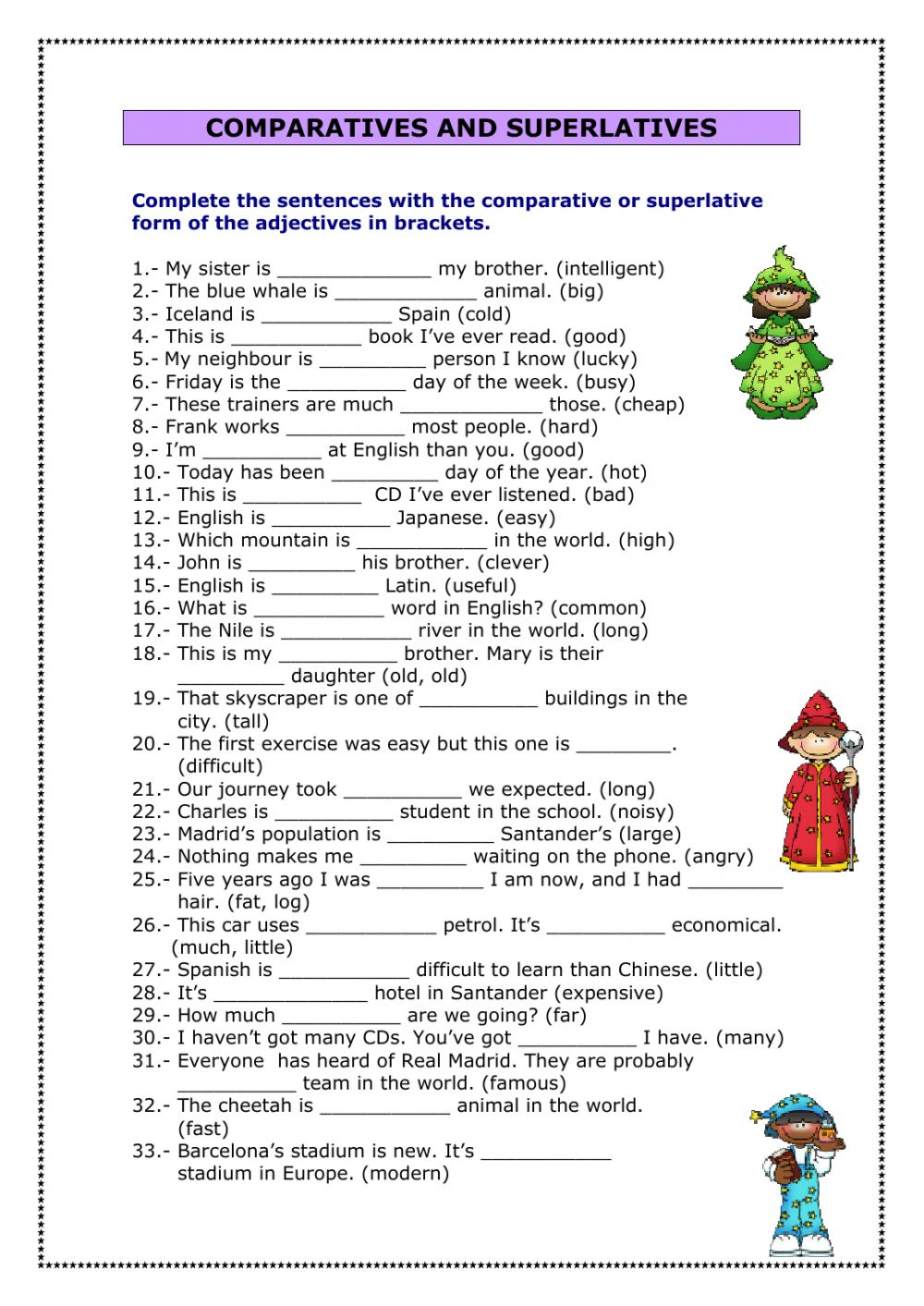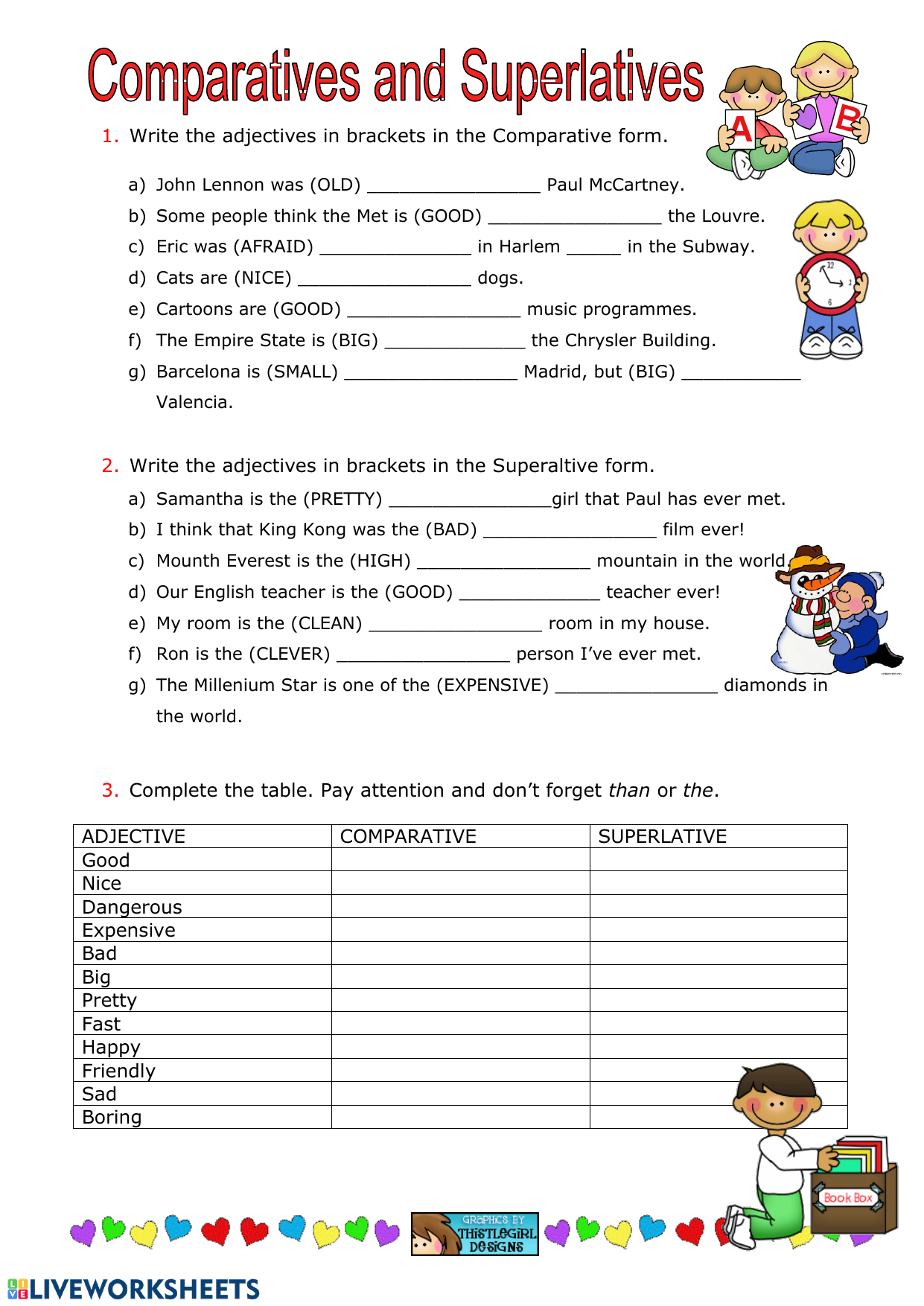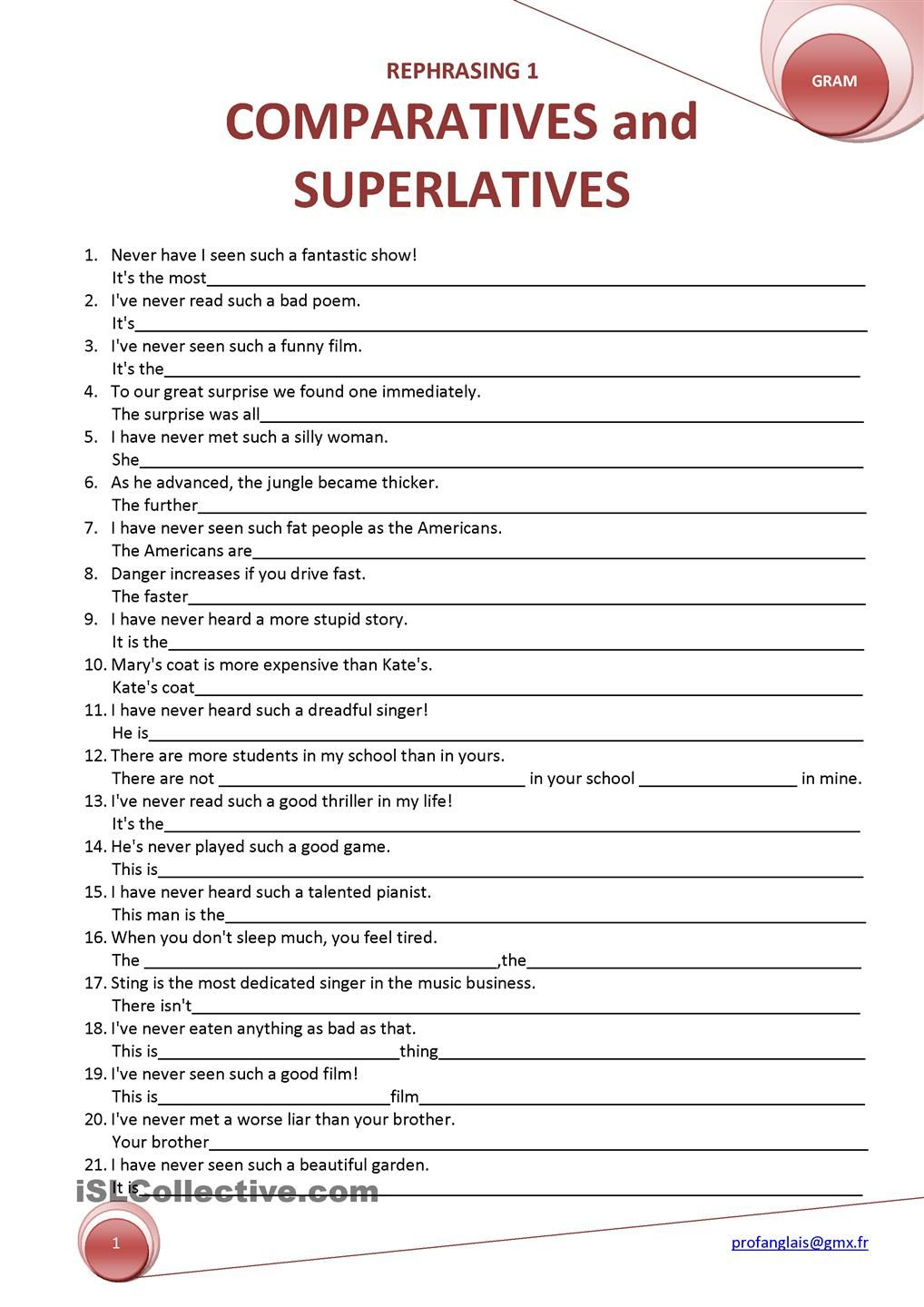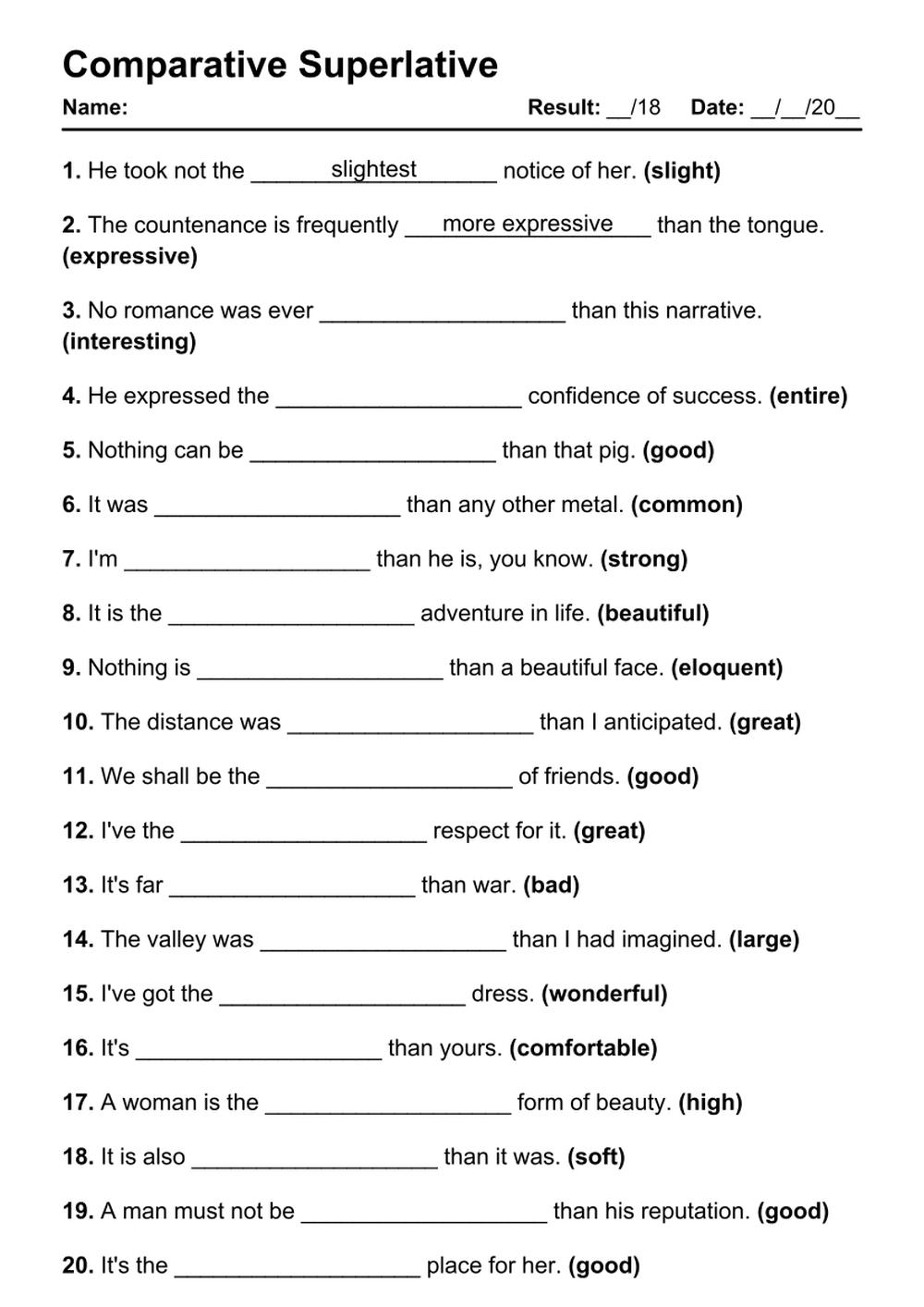
Mastering Comparisons: The Indispensable Role of Comparative and Superlative A2 Worksheets
In the journey of learning English, reaching the A2 level signifies a crucial step. Learners at this stage are moving beyond basic survival phrases and beginning to construct more complex sentences, express opinions, and describe the world around them with greater nuance. A pivotal grammatical concept that empowers A2 learners to achieve this is the use of comparatives and superlatives. These structures allow individuals to express differences and extremes, making their communication richer and more precise. To solidify this understanding and ensure practical application, well-designed comparative and superlative A2 worksheets become an indispensable tool for both educators and self-learners.
This article will delve into the significance of comparatives and superlatives at the A2 level, explore the multifaceted benefits of incorporating worksheets into the learning process, discuss the various types of effective A2-level exercises, and provide guidance on designing or selecting materials that truly foster mastery.

Understanding Comparatives and Superlatives at the A2 Level

Before diving into worksheets, it’s essential to grasp what comparatives and superlatives entail and why they are introduced at the A2 level.

Comparatives are used to compare two things, people, or ideas. They indicate that one item possesses a certain quality to a greater or lesser degree than another. For example, "This car is faster than that one," or "The red dress is more beautiful than the blue one." The rules for forming comparatives depend on the adjective’s length:

- Short adjectives (one syllable): Add "-er" (e.g., tall – taller, big – bigger).
- Two-syllable adjectives ending in -y: Change "y" to "i" and add "-er" (e.g., happy – happier, easy – easier).
- Long adjectives (two or more syllables not ending in -y): Use "more" before the adjective (e.g., expensive – more expensive, interesting – more interesting).
- Irregular adjectives: Some common adjectives have irregular comparative forms (e.g., good – better, bad – worse, far – farther/further).


Superlatives are used to compare three or more things, people, or ideas and identify the one that possesses a certain quality to the highest or lowest degree within a group. For example, "He is the tallest person in the class," or "This is the most exciting movie I’ve ever seen." Similar to comparatives, their formation depends on the adjective’s length:
- Short adjectives (one syllable): Add "-est" (e.g., tall – tallest, big – biggest).
- Two-syllable adjectives ending in -y: Change "y" to "i" and add "-est" (e.g., happy – happiest, easy – easiest).
- Long adjectives (two or more syllables not ending in -y): Use "most" before the adjective (e.g., expensive – most expensive, interesting – most interesting).
- Irregular adjectives: Some common adjectives have irregular superlative forms (e.g., good – best, bad – worst, far – farthest/furthest).



At the A2 level, learners are expected to understand and correctly apply these basic rules, recognizing the different forms for short and long adjectives, and starting to memorize common irregular forms. The focus is on practical application in everyday contexts, such as comparing family members, describing places, or expressing preferences.
The Power of Worksheets in Grammar Acquisition
Worksheets, often seen as traditional learning tools, remain incredibly effective, especially for grammar acquisition. They provide a structured, low-pressure environment for learners to practice and reinforce new concepts. For comparative and superlative structures, worksheets offer:
- Focused Practice: They isolate the specific grammar point, allowing learners to concentrate solely on forming and using comparatives and superlatives without the distraction of other complex grammatical structures.
- Repetition and Reinforcement: Grammar requires repetition to move from conscious understanding to automatic use. Worksheets provide ample opportunities for this, embedding the rules through repeated application.
- Immediate Application: Learners can immediately apply the rules they’ve just learned, which helps to solidify understanding and identify areas of confusion.
- Self-Correction and Feedback: Many worksheets come with answer keys, enabling self-correction. This fosters independent learning and allows learners to identify and rectify their own mistakes, reinforcing correct forms.
- Visual and Kinesthetic Learning: The act of writing, filling in blanks, and matching provides a kinesthetic element, while visual cues (pictures, diagrams) can aid comprehension, especially for visual learners.
- Assessment Tool: For teachers, worksheets serve as an excellent informal assessment tool, quickly revealing students’ understanding and highlighting common errors across the class.
Designing and Selecting Effective Comparative and Superlative A2 Worksheets
The effectiveness of a worksheet lies in its design and relevance to the learner’s level. For A2 learners, comparative and superlative A2 worksheets should be clear, engaging, and progressively challenging. Here are key types of exercises and considerations for their design:
-
Fill-in-the-Blanks:
- Description: The most common type, where learners complete sentences by choosing the correct comparative or superlative form of a given adjective.
- Example: "My brother is (tall) than me." "Mount Everest is (high) mountain in the world."
- A2 Focus: Start with regular adjectives, then introduce common irregulars gradually. Ensure the vocabulary in the sentences is A2-appropriate.
-
Sentence Completion/Transformation:
- Description: Learners are given a base sentence and asked to rewrite it using a comparative or superlative, or complete a sentence based on given information.
- Example: "The red car is fast. The blue car is faster. (Combine using comparative)" "London is big. Tokyo is bigger. Paris is big. (Which is the biggest?)"
- A2 Focus: Encourages understanding of sentence structure and direct application of the new forms.
-
Picture-Based Activities:
- Description: Learners compare or contrast objects/people shown in pictures.
- Example: Show pictures of two animals (e.g., elephant and mouse) and ask: "Which animal is (big) ?" "The elephant is (heavy) than the mouse." For superlatives, show three or more items.
- A2 Focus: Excellent for visual learners and helps contextualize the grammar in a clear, engaging way. The vocabulary is often simplified due to the visual aid.
-
Error Correction:
- Description: Learners identify and correct mistakes in sentences that contain incorrect comparative or superlative forms.
- Example: "She is more taller than her sister." (Correction: "She is taller than her sister.")
- A2 Focus: Develops critical thinking and reinforces correct usage by highlighting common errors.
-
Matching Exercises:
- Description: Learners match adjectives to their correct comparative or superlative forms, or match sentences to pictures that illustrate the comparison.
- Example: Match "good" to "better" and "best."
- A2 Focus: Good for quick recall and reinforcing the forms of irregular adjectives.
-
Dialogue/Conversation Prompts:
- Description: Worksheets provide short dialogues with blanks or prompts for learners to create their own comparative/superlative sentences in a conversational context.
- Example: "A: Which city do you like (good), Paris or Rome? B: I think Paris is (good) ____."
- A2 Focus: Bridges the gap between written practice and spoken application, preparing learners for real-life conversations.
-
Comparison Charts/Tables:
- Description: Learners are given data in a table (e.g., heights of people, prices of items) and asked to write sentences comparing them using comparatives and superlatives.
- Example: A table showing population of cities. Learners write: "City A is (large) than City B. City C is (large) city."
- A2 Focus: Integrates numerical data with grammar, promoting a more analytical approach to language use.
Key Considerations for Worksheet Design and Selection:
- Clarity of Instructions: Instructions must be simple, concise, and easy for an A2 learner to understand.
- A2-Appropriate Vocabulary: The vocabulary used within the sentences and questions should be familiar to A2 learners. Avoid introducing too many new words simultaneously with new grammar.
- Contextual Relevance: Use examples that are relatable to the learners’ lives (e.g., comparing family members, friends, hobbies, everyday objects, travel destinations). This makes the practice more meaningful.
- Gradual Difficulty: Start with simpler, regular forms before introducing irregulars and more complex sentence structures.
- Variety: To prevent boredom and cater to different learning styles, incorporate a mix of exercise types within a single worksheet or across a series of worksheets.
- Visual Appeal: Use clear fonts, sufficient white space, and, where appropriate, engaging images to make the worksheets inviting.
- Answer Keys: For self-study, provide clear answer keys. For classroom use, answer keys facilitate quick checking.
Integrating Comparative and Superlative A2 Worksheets into a Lesson Plan
Worksheets are most effective when integrated thoughtfully into a broader lesson plan, rather than being used in isolation. A typical sequence might include:
- Presentation: Introduce the concept of comparatives and superlatives, explaining the rules with clear examples.
- Guided Practice: Work through the first few exercises of a worksheet together as a class, addressing questions and clarifying doubts.
- Independent Practice: Allow learners to complete the rest of the comparative and superlative A2 worksheets individually or in pairs. Circulate to offer help and feedback.
- Review and Correction: Go over the answers as a class, discussing common errors and reinforcing correct forms.
- Production/Application: Transition from written practice to spoken or written production. Encourage learners to create their own sentences using comparatives and superlatives about themselves, their families, or their environment. This could involve speaking activities (e.g., "Compare two famous people"), debates ("Is city life better than country life?"), or short writing tasks (e.g., "Describe your ideal holiday destination and compare it to another place you’ve visited").
The Long-Term Benefits of Focused Worksheet Practice
The diligent use of comparative and superlative A2 worksheets offers long-term benefits beyond simply mastering a grammar point. They contribute significantly to a learner’s overall linguistic confidence and fluency. By consistently practicing these structures, learners become more adept at expressing nuanced ideas, which is crucial for moving towards B1 and higher levels. They learn to differentiate between similar items, articulate preferences, and make informed statements about the world around them. This foundational understanding not only improves grammatical accuracy but also enhances their ability to engage in more sophisticated conversations and writing tasks.
Moreover, the structured nature of worksheets helps learners develop a systematic approach to language learning. They learn to identify patterns, apply rules, and self-correct, skills that are transferable to other grammatical concepts. For teachers, these worksheets are invaluable for diagnosing learning gaps and tailoring instruction to individual needs, ensuring that every student has the opportunity to grasp these essential comparative structures.
Conclusion
In conclusion, the journey through the A2 level of English proficiency is marked by the acquisition of fundamental grammatical structures that enable more sophisticated communication. Among these, comparatives and superlatives stand out as vital tools for expressing differences and extremes. The strategic use of comparative and superlative A2 worksheets is not merely a supplementary activity but a cornerstone of effective learning and teaching at this level. They provide the necessary repetition, focus, and practical application that transform abstract grammatical rules into usable language skills. By thoughtfully designing and integrating these worksheets into the curriculum, educators can empower A2 learners to confidently navigate comparisons, articulate their perspectives with greater precision, and build a robust foundation for continued linguistic growth. The path to fluency is paved with consistent practice, and well-crafted worksheets are undoubtedly one of the most effective paving stones.
